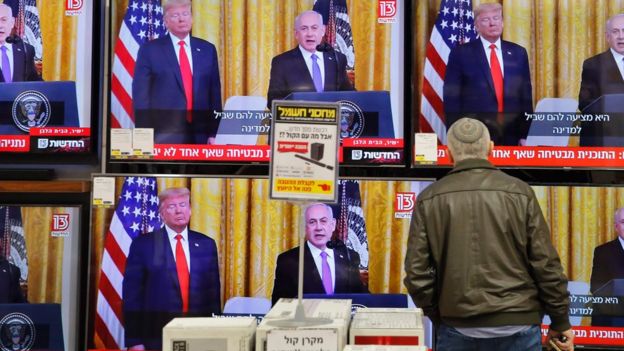“When someone arrives to talk peace, prepare for war,” an Israeli told me this week.Palestinians and Israelis know from decades of history that past peace initiatives are strewn with turbulence, division and bloodshed.But the Oslo Accords of the 1990s also left a structure in place, however fragile, that was meant to become the basis for a permanent peace – the so-called “two-state solution”.It calls for an independent Palestinian state made up of the West Bank and Gaza with East Jerusalem as its capital, alongside a secure state of Israel along the territorial lines shown on the map before the 1967 Middle East war.
US President Donald Trump appeared to want to shake up the paradigm – claiming that it has failed for over two decades to achieve peace.
He chose instead to follow a different logic of deal-making – one that ultimately lends American support overwhelmingly in favour of Israel, the more powerful partner, and formalises changed facts on the ground: Israel’s building of Jewish settlements over four decades in the West Bank.
Even in the lead-up to Mr Trump’s announcement, such a shift by the superpower sponsor of peace was causing consternation for many in the region.
I took a walk through Jerusalem’s Old City on the eve of the unveiling of the “deal of the century”. Near Damascus Gate in the Muslim Quarter, the first mention of Mr Trump’s plan to a seller of fruits and dates leads to a warning of “more violence, more trouble”.
“He’s not making the country for Palestine,” said Tawfiq Halawani. “We don’t give up if we don’t get Jerusalem… it’s the holy place for us. Trump, he can say anything, it’s not important. We have our life here – we sit here.”
It is hard to overstate the significance of this small patch of Ottoman-walled territory that slopes down gently towards a rocky base in the Jerusalem hills.
It contains most of the city’s sensitive religious sites – including the Dome of the Rock, the Western Wall and the Church of the Holy Sepulchre. It lies in East Jerusalem, effectively annexed by Israel in 1980 in a move not internationally recognised, which Palestinians want as their future capital.
President Trump’s plan envisages a Palestinian capital not here, but in suburbs of East Jerusalem located beyond Israel’s separation barrier. The barrier’s route was determined by what Israel saw as its security needs, and cuts through the Jerusalem municipality, effectively dividing the city for many Palestinian residents.

Many East Jerusalemite Palestinians beyond the barrier live in under-served and deprived areas, including a major refugee camp, having to cross checkpoints daily to work or visit relatives.
I asked another resident, Nabil Ismine, about placing a capital in Jerusalem’s suburbs. He explained the depth of the connections of people like him to the heart of the Old City. “My father, grandfather were born here, near the al-Aqsa [mosque]. We lived here all the time… we believe this is our country delivered from the sky, from God.”
Palestinian Authority President Mahmoud Abbas said: “It’s impossible to accept any Palestinian state without Jerusalem [as its capital]”.
Here, the heavily armed, green-uniformed border police are a reminder to Israelis of their sense of security. To Palestinians they are the everyday symbol of occupation.
The Trump plan prioritises Israel’s security needs when it comes to the allocation of territory. It would recognise all the settlements in the West Bank as an official part of Israel.
I carried on walking towards the Western Wall, the holiest site where Jews can pray. In the narrow alleys on the way, Israeli boys sing “a redeemer came to Zion”, words from a religious song.
An Israeli woman stopped and we mentioned the Trump plan. “It’s great, I love him,” she said. “He knows what the Jewish people need in all the world.”
The Trump document says applying Israeli sovereignty to the settlements would be compensated by land swaps to Palestinians. It would also recognise Israeli sovereignty over the strategically important Jordan Valley, a key swathe of land in the West Bank important for agriculture running along the border with neighbouring Jordan.
This, said Israel’s Prime Minister Benjamin Netanyahu in the White House, recognises that “Israel must have sovereignty in places that enable Israel to defend itself by itself”. He described the proposals, including applying Israeli law to the settlements, as the “opportunity of the century” for Israel.
But Palestinians say the move will entrench apartheid.
Further into the Old City’s Jewish Quarter I visited the shop of Rabbi Eyal Avital. On the wall of his shop selling religious jewellery is a copy of a front page of the New York Post which reads: “Promised Land”. It shows a picture of him praising God by the Western Wall on the day President Trump recognised Jerusalem as Israel’s capital in December 2017.
Rabbi Avital reflects the beliefs of many nationalist religious Israelis, who provided the base to a key wing of Mr Netanyahu’s coalition governments. “We have come back to it after 2,000 years,” he says. “Now Israel comes to the land and makes it paradise.”
He believes the entire West Bank should be under Israeli control as he says the land is given by God. And so, he says, any support for negotiations towards a future Palestinian state would stop him voting for Mr Netanyahu.
Meanwhile, many on the Israeli left will reject much of the American proposal, which they see as destroying the chances for a two-state solution as previously envisaged, and see the plan as interference in Israel’s election.
Many here are now reflecting on a surprising spectacle in the White House – a US president celebrating the prospects of a deal in which only one side was present. It is what led the Palestinians to say President Trump is “clapping with one hand”.










